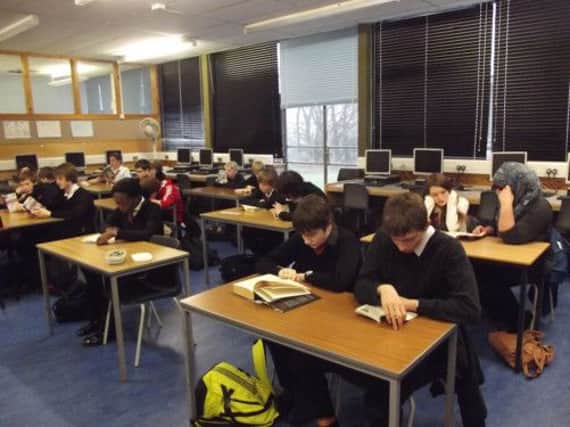One in five secondary pupils fails to meet standards


SEE ALSO:
The first Scottish Survey of Literacy and Numeracy (SSLN) published yesterday assessed children in primary four, primary seven and second year of high school in reading, writing, listening and talking.
Advertisement
Hide AdAdvertisement
Hide AdWhile more than 90 per cent of pupils are within or above the expected level for reading and writing, the figures show a continuing dip in performance between the end of primary school and the start of secondary.
The research, which is based on a survey of 10,100 pupils, found 17 per cent of those in S2 are not yet “working within their level” in listening and talking.
While only one per cent of P4 pupils and two per cent of those in P7 are not reaching the required standard in writing, the figure rises to seven per cent for those in S2.
The figures also show that despite attempts by Holyrood to address the so-called “attainment gap”, there remains a huge disparity between the performance of those from deprived areas and the more well-off.
At S2 level, the percentage of pupils from better-off areas who were performing “well” or “very well” at reading was 16 points higher than those living in more deprived backgrounds.
The Scottish Government said that, overall, the figures showed the Curriculum for Excellence, which was introduced in 2010, is helping to drive up standards in literacy. But critics said “significant concerns” remained.
Learning minister Alasdair Allan said: “Schools across Scotland are doing a good job and we know from recent inspection reports that they continue to improve.
“I am pleased that our schools are achieving and sustaining high performance in reading and writing, with more than 90 per cent performing within or above expected levels.
Advertisement
Hide AdAdvertisement
Hide Ad“We want all children to achieve their full potential and that is why we continue to focus on driving up standards. Curriculum for Excellence makes literacy the responsibility of all teachers, while pupils now focus on these key skills across learning.”
Carried out in May 2012, the SSLN consisted of a set of written and practical literacy assessments, a pupil questionnaire and a teacher questionnaire completed by 4,900 teachers.
The survey and its complementary numeracy study, which was published last year, replace the Scottish Survey of Achievement (SSA) which ran from 2004 to 2009.
The survey also found the desire to learn and the “engagement with learning” fell with the increasing age of the child.
Tory education spokeswoman Liz Smith MSP said the continuing dip between primary and secondary school showed a need to reintroduce testing for younger children. “There is a continuing trend of general attainment levels slipping back between the middle years of primary school and the early years of secondary school,” she said.
“One in five pupils in S2 still struggles with basic skills in listening and talking and we still have only a small handful of S2 pupils who produce results beyond their schools’ predictions.
“Literacy and numeracy is the cornerstone of good-quality Scottish education and that is why the Scottish Conservatives believe very firmly that there should be much rigorous testing of the basic skills before pupils leave primary school.”
But Larry Flanagan, leader of the Educational Institute of Scotland (EIS), the country’s largest teaching union, said: “Generally speaking, the survey results offer a welcome reassurance that pupils continue to perform well in Scottish schools and that key aspects of CfE are taking root.”